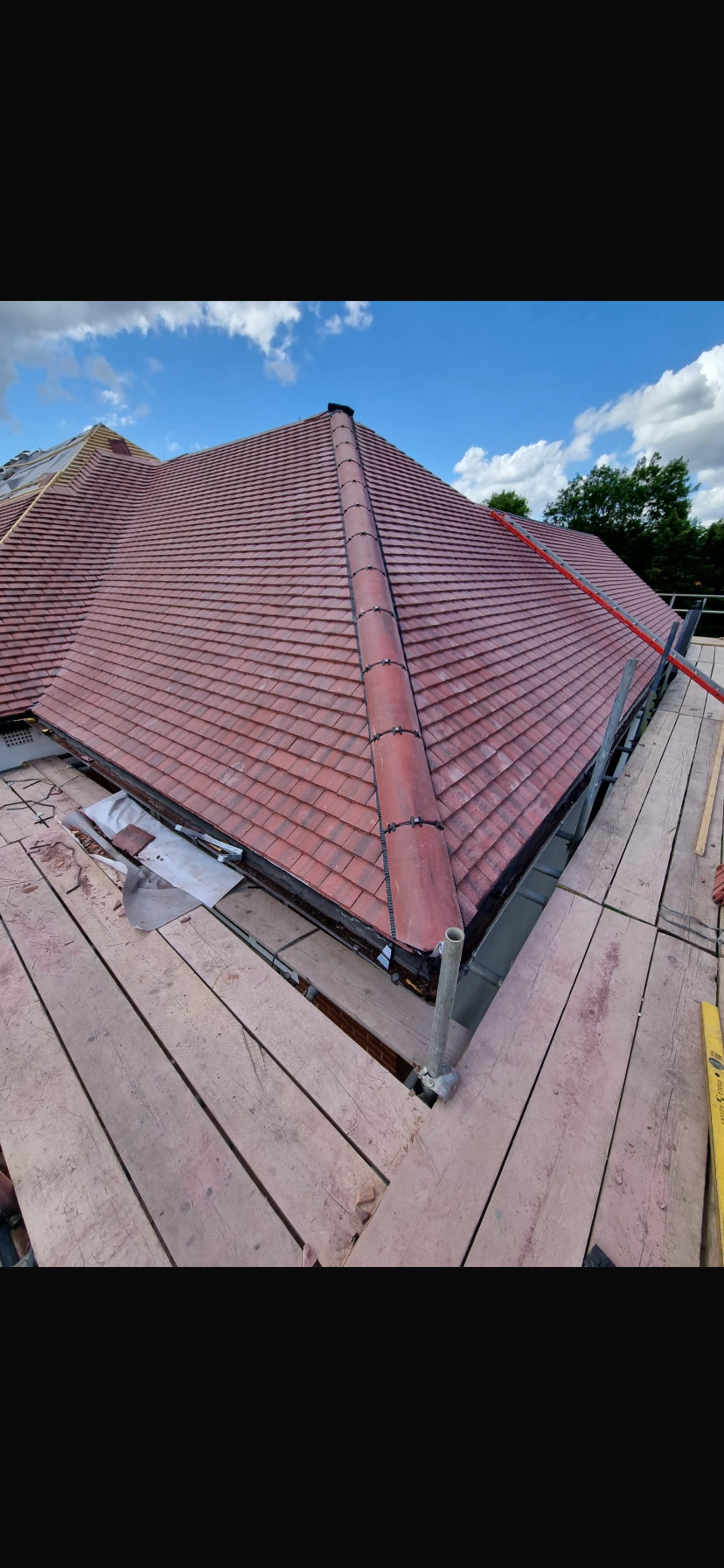+44 7853 968135
What is the most common roof repair?
Understanding the most common roof repair issues can save UK property owners thousands of pounds in unnecessary damage and emergency callouts. Professional roofers consistently report that tile and slate replacement accounts for approximately 65% of all residential repair work across the country, making it the single most frequent roofing maintenance requirement.
Weather conditions, material degradation, and poor installation practices contribute to this overwhelming trend, with storm damage alone responsible for nearly 40% of emergency roof repairs during autumn and winter months. Property owners who recognise early warning signs and address common issues promptly typically spend 60% less on roofing maintenance over their property’s lifetime compared to those who adopt reactive approaches.
Missing and Damaged Tiles: The Leading Roof Repair Issue
Missing or damaged roof tiles represent the most prevalent repair requirement across UK properties, affecting millions of homes annually regardless of age or roofing material type. Strong winds, thermal expansion cycles, and natural material degradation create the perfect conditions for tile displacement and cracking, particularly during severe weather events.
Professional roofers report that individual tile replacement accounts for more emergency callouts than all other roofing issues combined, with autumn storms generating peak demand periods. The immediate risk of water penetration through exposed roof areas makes this repair type particularly urgent, often requiring same-day attendance to prevent interior damage.
Need some Support with your Roof Repairs? Speak with a member of our Professional Roof Replairs Team here

What is the Most Common Roof Damage?
Compromised flashing systems create the second most common source of roof leaks, particularly around chimneys, valleys, and dormer windows where different roof sections intersect. These critical waterproofing elements experience constant thermal stress from temperature fluctuations, causing expansion joints to fail and create water ingress points.
Lead flashing deterioration affects properties over 20 years old most severely, with material fatigue and poor installation practices contributing to premature failure rates. Modern synthetic alternatives offer improved longevity and thermal stability, though proper installation techniques remain crucial for long-term performance.
Regular flashing inspection and maintenance prevents approximately 80% of leak-related issues, making it one of the most cost-effective preventive measures available to property owners. Professional assessments identify early signs of flashing compromise before visible leaks develop, protecting both structural integrity and interior finishes.
Seasonal Roof Damage Patterns Across the UK
Different seasons present unique challenges for UK roofing systems, with specific damage types correlating strongly with weather patterns and temperature variations throughout the year. Understanding these seasonal trends helps property owners schedule appropriate maintenance activities and prepare for common repair requirements.
Winter freeze-thaw cycles cause significant tile stress and cracking, particularly affecting clay and concrete materials that absorb moisture during autumn months. Spring storms following winter damage create peak repair demand, often resulting in extended waiting times for professional services and premium pricing for urgent work.
Summer UV exposure gradually degrades roofing materials and sealants, creating conditions for autumn failure when thermal stress combines with increased moisture exposure. This cyclical pattern explains why proactive summer maintenance significantly reduces winter emergency repairs and associated costs.
Professional Roof Repair Cost Analysis and Budgeting
| Repair Type | Material Cost | Labour Cost | Total Range | Duration |
|---|---|---|---|---|
| Single Tile Replacement | £15-£45 | £120-£200 | £135-£245 | 2-4 hours |
| Flashing Repair (Linear metre) | £25-£60 | £150-£300 | £175-£360 | Half day |
| Ridge Tile Replacement | £80-£150 | £250-£450 | £330-£600 | Full day |
| Small Leak Patch Repair | £50-£100 | £200-£400 | £250-£500 | Half day |
| Gutter Realignment (per section) | £30-£80 | £100-£250 | £130-£330 | 3-5 hours |
| Emergency Storm Repair | £100-£200 | £300-£600 | £400-£800 | Variable |
Labour costs typically represent 70-80% of total repair expenses, reflecting the skilled nature of roofing work and mandatory safety requirements for working at height. Regional variations significantly impact pricing, with London and South East England commanding premium rates compared to northern regions.
Material matching presents additional cost considerations for older properties where original tiles may require sourcing from specialist suppliers. Heritage properties and conservation areas often mandate specific material types, increasing both material costs and installation complexity for repair work.
What is the Most Expensive Part of a New Roof?
Labour costs typically represent the largest expense component in new roof installations, often accounting for 60-70% of the total project budget. Skilled roofers command premium rates due to the specialised nature of their work and the safety risks involved in working at height.
Material selection significantly impacts overall costs, with natural slate commanding the highest prices but offering superior longevity compared to alternatives. The Health and Safety Executive guidelines mandate specific safety equipment and procedures for roofing work, which professional contractors incorporate into their pricing structures to ensure compliance and worker protection.
Common Roof Problems by Season
| Season | Primary Issues | Prevention Methods |
|---|---|---|
| Spring | Storm damage, loose tiles | Post-winter inspection |
| Summer | UV damage, expansion cracks | Regular maintenance checks |
| Autumn | Blocked gutters, moss growth | Gutter cleaning, moss treatment |
| Winter | Ice damage, freeze-thaw cycles | Adequate insulation, ventilation |
Understanding the Most Common Roof Repair Needs
Tile and slate replacement consistently emerges as the most frequent roof repair requirement across UK properties, driven by weather exposure and natural material degradation over time. This fundamental maintenance need affects virtually all roof types, regardless of age or initial installation quality, making it an inevitable aspect of property ownership.
Regular inspection programmes enable early identification of developing problems, preventing minor tile displacement from escalating into more serious structural issues. Professional roofers recommend bi-annual inspections, particularly following severe weather events, to maintain roof integrity and extend overall system lifespan.
Property owners who address common repair needs promptly typically experience lower long-term maintenance costs and avoid the complications associated with water damage to interior spaces. The proactive approach to roof maintenance demonstrates both financial prudence and responsible property stewardship.
Need Help with Repairing your Roof? Talk to one of our Roof Repair Experts today!
What is the Most Common Roof Repair: Frequently Asked Questions
Individual roof tile or slate replacement requires matching materials, roofing cement, and appropriate fixings such as nails or clips. Professional roofers also use specialist tools including safety equipment, tile rippers, and weatherproofing compounds to ensure secure, long-lasting repairs.
Properly executed tile replacements and minor repairs generally last 15-25 years, matching the lifespan of surrounding original materials. The longevity depends heavily on material quality, installation standards, and ongoing maintenance practices throughout the roof’s operational life.
Working at height presents significant safety risks that require proper training, equipment, and insurance coverage for legal compliance. Most insurance policies and building regulations strongly recommend professional installation to ensure both safety standards and warranty protection remain valid. For more detailed information about roofing systems and their components, visit the roofing Wikipedia page.
Dry conditions with minimal wind provide optimal circumstances for roof repair work, ensuring proper material adhesion and worker safety. Professional roofers typically avoid working during wet weather, high winds exceeding 25mph, or when frost conditions might affect material performance and installation quality.
Visual inspection from ground level often reveals missing or displaced tiles, whilst interior signs include water stains on ceilings or walls during rainfall. Professional surveys provide comprehensive assessments, but homeowners should monitor their properties for obvious damage following severe weather events.
Minor repairs and like-for-like replacements typically fall under permitted development rights and don’t require formal planning applications. However, the Planning Portal guidance provides specific criteria, and building control notification may be necessary for extensive repairs affecting structural elements or insulation systems.
Material costs, accessibility challenges, extent of damage, and regional labour rates all impact repair pricing significantly. Properties with complex roof designs, listed building status, or requiring specialist materials typically incur higher costs than straightforward repairs on standard residential buildings.
Most home insurance policies cover storm damage and sudden, unexpected failures but exclude gradual wear and maintenance issues. Policy holders should review their specific terms and maintain evidence of regular maintenance to support claims for covered damage events.
Regular gutter cleaning, moss treatment, and professional inspections significantly reduce repair frequency by addressing minor issues before they escalate. Tree pruning near roof areas and ensuring adequate ventilation also contribute to longer material lifespan and fewer emergency repairs.
Spring and early summer provide optimal conditions for repair work, allowing proper material curing before winter weather arrives. Scheduling repairs during favourable weather conditions ensures better workmanship quality and reduces the risk of weather-related installation problems.
Reputable roofing contractors should possess relevant trade qualifications, public liability insurance, and membership in recognised trade bodies such as the National Federation of Roofing Contractors. Proper credentials ensure compliance with health and safety regulations and provide consumer protection through professional standards enforcement.
Natural slate typically requires less frequent replacement but costs more per unit, whilst clay tiles offer good durability with moderate replacement costs. Concrete tiles represent the most economical option but may require more frequent maintenance, and each material type demands specific repair techniques and compatible replacement components.
Professional roof repairs require safety harnesses, non-slip footwear, ladders meeting British Standards, and scaffold systems for extensive work. Specialist tools include tile lifters, slate rippers, pointing trowels, and weatherproofing materials, all of which contribute to both safety and repair quality standards.
Building regulations ensure structural safety and energy efficiency standards are maintained during repair work, particularly when replacing significant roof areas. The regulations cover aspects including insulation requirements, ventilation provision, and structural loading calculations, making professional consultation advisable for extensive repairs.

